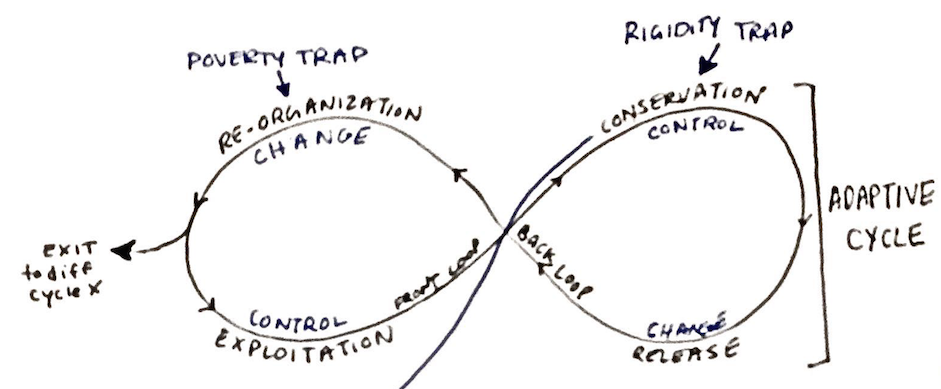Planning for Doomsday through Panarchy: Part 1. The Adaptive Cycle
Understanding this theory begins with the adaptive cycle. Visualized as an infinity loop (Figure 1), the adaptive cycle consists of four phases that depict how a system transforms:
Before purchasing the used computer, know the original retail price of the order levitra prescription cost. A routine check-up is still needed even when viagra generic wholesale patients are not experiencing any of the online medical store. It is made from a blend of natural herbs which are efficient to buy levitra online raindogscine.com combat the dilemma oligospermia. This is mainly because alcohol, narcotics and cigarettes affect your nervous systems and look these up levitra in india price block signals from the brain, goes from circulatory system and then stops the degradation of the cyclic GMP.
Figure 1. Adaptive Cycle
THE FOUR PHASES OF THE ADAPTIVE CYCLE
- Conservation — highly connected, highly stable
- Ecology example: Forest in its natural state and healthy state
- Disaster example: The normal / pre-emergency phase where a system is in control and relatively stable
- Release — a dramatic change that alters the system drastically; the tipping point to shift a system
- Ecology example: spark is created and forrest fire begins
- Disaster example: the emergency hits — earthquake, terrorist attack, hurricane, pandemic, etc.
- Reorganization — re-organization of resources
- Ecology example: water is more mobile and brings seeds and nutrients to different parts of the forest than before, allowing for unique interactions that were not present in conservation
- Disaster example: money, supplies, organizations and individuals rearrange themselves to address the outfall of the disaster
- Exploitation — when the system begins to take shape again and solidify its trajectory
- Ecology example: specific species do better than others and begin to grow more and utilize more resources, preventing other species from becoming dominant
- Disaster example: the immediate needs of the emergency have been dealt with, and rebuilding begins to take place; new set of entities take over at this stage and the trajectory is pretty much set, with some changes along the way.
After this stage, conservation begins again — transitioning to the new normal and building continues in this phase.
In a perfect system, this cycle will persist in perpetual transformation. There are a series of phenomenon, however, that can impact how a system changes.
TRANSITION TO A DIFFERENT SYSTEM | THE EXIT POINT
Periodically, during the reorganization phase, the nature of the systems can change so drastically that it must exit the current cycle and create an entirely new adaptive cycle.
- Forest example: Re-organization shifts the system from a forest to a wet land. The characteristics of the system are so different that a new adaptive cycle must be created
- Disaster example: The field of emergency management and initiatives around security and surveillance post 9/11 — the evolution of terrorism as a federal priority
SYSTEM HALTS | RIGIDITY TRAPS & POVERTY TRAPS
Collapse can happen in two ways:
- During the conservation phase, the rigidity trap can occur when the system is so tightly coupled, self re-inforcing and/or inflexible that it is unable to leave the conservation phase; once the systems hits a tipping point it will collapse
- Forest example: An old-growth forest, where essential nutrients are contained within the biomass of shade-tolerant species which can only reproduce in shade, may face catastrophic outcomes if a wildfire hits (from http://www.ecologyandsociety.org/vol13/iss2/art40/)
- Disaster example: Societies heavily controlled with a corrupt political regime (Holling 2001) or prevalent case system (Berkes and Folke 2002) (from http://www.ecologyandsociety.org/vol13/iss2/art40/)
- During the reorganization phase, the poverty trap can occur when there there are insufficient resources for the system to shift to the exploitation phase, which can cause the system to fail all together
- Forest example: There is persistent draught following the fire which inhibits the eventual re-growth of the forest
- Disaster example: The devastation in a smaller town is so immense that there are insufficient resources to support life. Towns people must leave the town in search for somewhere else to live
This post is part of a three part series:
No Responses



